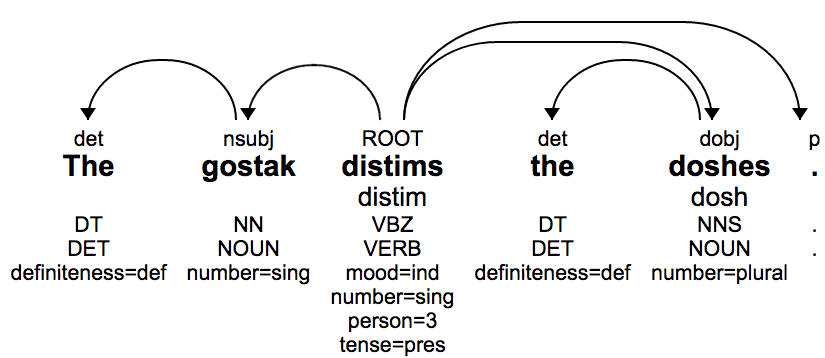
Google has upgraded certain aspects of its artificial-intelligence tools. Those upgrades include a major one to the open-source
SyntaxNet (Github link), giving the platform a keener understanding of how languages are structured. “At the core of the upgrade is a
new technology that enables learning of richly layered representations of input sentences,” reads Google’s
official blog posting on the matter. “More specifically, the upgrade extends
TensorFlow to allow joint modeling of multiple levels of linguistic structure, and to allow neural-network architectures to be created dynamically during processing of a sentence or document.” With the new technology in place, developers can create models that compose individual characters and letters into words (Google’s example: “e.g. ‘c-a-t spells ‘cat’”); the models, in turn, should learn that words relate to one another via a common sharing of parts—opening the system to an understanding of things like plurals:

“Based on this analysis we can then derive the overall structure of [sentences] even though we have never seen the words before,” continues Google’s blog. That’s potentially a powerful feature for any tech pro working on software designed to recognize and interact with human language, such as a bot. In conjunction with the SyntaxNet upgrade, Google is releasing a set of “pretrained” models, collectively known as
ParseySaurus, which can correctly predict and analyze sentences. In an effort to increase awareness of the software, Google is hosting a competition (in conjunction with Charles University and other entities) at this year’s Conference on Computational Natural Language Learning (CoNLL), which will ask participants to build syntactic parsing systems that “work well in real-world settings and for 45 different languages.” You can sign up to compete at
universaldependencies.org. While machine-learning platforms focused on language might seem a little esoteric, such technology may undergird increasingly critical systems for both consumers and businesses. An A.I. capable of parsing speech can better respond to users’ natural-language requests, making digital assistants, chatbots, and other platforms that much more effective.
 Google has upgraded certain aspects of its artificial-intelligence tools. Those upgrades include a major one to the open-source SyntaxNet (Github link), giving the platform a keener understanding of how languages are structured. “At the core of the upgrade is a new technology that enables learning of richly layered representations of input sentences,” reads Google’s official blog posting on the matter. “More specifically, the upgrade extends TensorFlow to allow joint modeling of multiple levels of linguistic structure, and to allow neural-network architectures to be created dynamically during processing of a sentence or document.” With the new technology in place, developers can create models that compose individual characters and letters into words (Google’s example: “e.g. ‘c-a-t spells ‘cat’”); the models, in turn, should learn that words relate to one another via a common sharing of parts—opening the system to an understanding of things like plurals:
Google has upgraded certain aspects of its artificial-intelligence tools. Those upgrades include a major one to the open-source SyntaxNet (Github link), giving the platform a keener understanding of how languages are structured. “At the core of the upgrade is a new technology that enables learning of richly layered representations of input sentences,” reads Google’s official blog posting on the matter. “More specifically, the upgrade extends TensorFlow to allow joint modeling of multiple levels of linguistic structure, and to allow neural-network architectures to be created dynamically during processing of a sentence or document.” With the new technology in place, developers can create models that compose individual characters and letters into words (Google’s example: “e.g. ‘c-a-t spells ‘cat’”); the models, in turn, should learn that words relate to one another via a common sharing of parts—opening the system to an understanding of things like plurals:  “Based on this analysis we can then derive the overall structure of [sentences] even though we have never seen the words before,” continues Google’s blog. That’s potentially a powerful feature for any tech pro working on software designed to recognize and interact with human language, such as a bot. In conjunction with the SyntaxNet upgrade, Google is releasing a set of “pretrained” models, collectively known as ParseySaurus, which can correctly predict and analyze sentences. In an effort to increase awareness of the software, Google is hosting a competition (in conjunction with Charles University and other entities) at this year’s Conference on Computational Natural Language Learning (CoNLL), which will ask participants to build syntactic parsing systems that “work well in real-world settings and for 45 different languages.” You can sign up to compete at universaldependencies.org. While machine-learning platforms focused on language might seem a little esoteric, such technology may undergird increasingly critical systems for both consumers and businesses. An A.I. capable of parsing speech can better respond to users’ natural-language requests, making digital assistants, chatbots, and other platforms that much more effective.
“Based on this analysis we can then derive the overall structure of [sentences] even though we have never seen the words before,” continues Google’s blog. That’s potentially a powerful feature for any tech pro working on software designed to recognize and interact with human language, such as a bot. In conjunction with the SyntaxNet upgrade, Google is releasing a set of “pretrained” models, collectively known as ParseySaurus, which can correctly predict and analyze sentences. In an effort to increase awareness of the software, Google is hosting a competition (in conjunction with Charles University and other entities) at this year’s Conference on Computational Natural Language Learning (CoNLL), which will ask participants to build syntactic parsing systems that “work well in real-world settings and for 45 different languages.” You can sign up to compete at universaldependencies.org. While machine-learning platforms focused on language might seem a little esoteric, such technology may undergird increasingly critical systems for both consumers and businesses. An A.I. capable of parsing speech can better respond to users’ natural-language requests, making digital assistants, chatbots, and other platforms that much more effective. 


